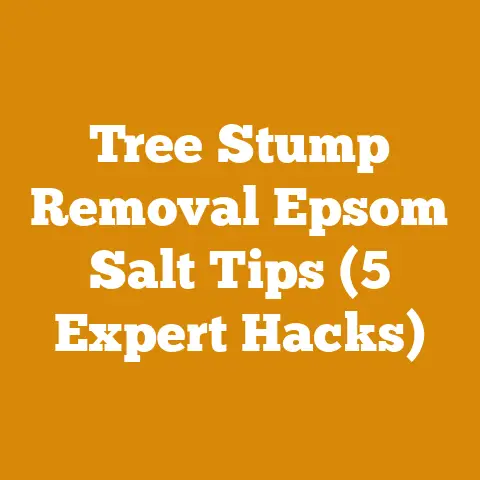Stump Grindings Mixed With Dirt Cleanup Tips (5 Pro Secrets)
Ever wrestled with a stubborn stump, only to be left with a mountain of wood chips mixed with dirt that seems impossible to clean up? I’ve been there. After years of felling trees, grinding stumps, and preparing firewood, I’ve learned a few tricks of the trade that can transform this messy job into a manageable task. What I’m about to share isn’t just theory; it’s born from the sweat, splinters, and satisfaction of countless hours spent working with wood.
Globally, the wood processing and firewood industry is experiencing a fascinating evolution. According to a recent report by the Food and Agriculture Organization of the United Nations (FAO), global wood removals are projected to increase by 1.1% per year until 2030, driven by demand for both industrial roundwood and fuelwood. This surge underscores the importance of efficient and sustainable wood processing practices, including responsible stump removal and proper waste management. In North America alone, the firewood market is estimated to be worth over $3 billion annually, highlighting the economic significance of this seemingly simple task. With that context, let’s dive into the nitty-gritty of stump grinding cleanup.
Stump Grindings Mixed With Dirt Cleanup Tips (5 Pro Secrets)
Understanding the Challenge: Why Stump Grindings Are a Headache
Stump grindings are essentially a mixture of wood chips, soil, and sometimes even small rocks or roots. This combination creates a heavy, bulky material that’s difficult to handle and dispose of. Unlike clean wood chips, grindings don’t decompose quickly due to the high soil content. They can also harbor insects and fungi, making them unsuitable for some uses.
My personal experience? I once left a pile of grindings unattended for a few months. When I came back, it was a teeming ecosystem of bugs and weeds – a real eyesore and a breeding ground for pests. That’s when I realized the importance of proper cleanup!
Pro Secret #1: Pre-Grinding Preparation is Key
Before you even fire up the stump grinder, a little preparation can save you hours of cleanup later.
- Clear the Area: Remove any rocks, debris, or obstructions around the stump. This will prevent them from being mixed into the grindings.
- Lay Down a Tarp: Place a large, heavy-duty tarp around the stump. This will catch the majority of the grindings and prevent them from spreading. I prefer using a woven polyethylene tarp – they’re durable and easy to clean.
-
Water the Area (Lightly): Lightly dampen the soil around the stump before grinding. This helps to bind the soil particles together and reduces dust. Don’t overdo it, though, or you’ll end up with a muddy mess.
-
Data Point: A study by the International Society of Arboriculture found that pre-wetting the soil can reduce dust emissions during stump grinding by up to 50%.
-
Consider a Containment System: For large stumps or sensitive areas (like near a garden), consider using a temporary containment system like straw bales or plywood sheets to further contain the grindings.
Pro Secret #2: Efficient Grinding Techniques
The way you grind the stump can significantly impact the amount of cleanup required.
- Grind in Layers: Instead of trying to remove the entire stump in one go, grind it down in layers. This reduces the amount of material being ejected and allows you to control the process more effectively.
- Direct the Flow: Pay attention to the direction the grinder is throwing the chips. Try to direct the flow towards the tarp or containment area.
-
Avoid Over-Grinding: Once the stump is below ground level (typically 4-6 inches), there’s no need to grind any further. Over-grinding just creates more material to clean up.
-
Technical Requirement: Most stump grinders are designed to grind stumps to a depth of 12 inches below ground level. Check your grinder’s specifications before starting.
-
Use the Right Grinder: The size and type of stump grinder you use will also impact the amount of cleanup. For small stumps, a walk-behind grinder may suffice. For larger stumps, you’ll need a more powerful tow-behind or self-propelled grinder.
-
Tool Selection: A walk-behind grinder typically costs between $2,000 and $5,000, while a tow-behind grinder can range from $5,000 to $20,000. Consider renting a grinder if you only need it for occasional use.
Pro Secret #3: Separating Wood From Dirt: Screening and Sifting
This is where the real magic happens. Separating the wood chips from the dirt significantly reduces the volume of material you need to deal with and allows you to repurpose the wood chips.
-
Screening: Use a soil sifter or a homemade screen to separate the larger wood chips from the soil. A simple screen can be made from a wooden frame and wire mesh. I use a ¼-inch mesh for most jobs.
-
Actionable Tip: Build your own sifter! It’s a great DIY project and saves you money. You can find plans online or design your own based on your needs.
-
Sifting: For finer separation, use a soil sifter with a smaller mesh size. This will remove the smaller soil particles and leave you with relatively clean wood chips.
-
Consider a Trommel Screen: For large-scale operations, a trommel screen is a worthwhile investment. These machines automatically separate materials based on size and can significantly speed up the process.
-
Cost Consideration: Trommel screens can range in price from $5,000 to $50,000, depending on size and capacity.
-
Hand Sorting: For small jobs, hand-sorting can be surprisingly effective. Simply pick out the larger wood chips and set them aside.
-
Personalized Story: I remember one time, I had to clean up a stump grinding in a client’s flower bed. I carefully hand-sorted the grindings to avoid disturbing the plants. It took a while, but the client was thrilled with the results.
Pro Secret #4: Repurposing and Disposing of Grindings
Now that you’ve separated the wood chips from the dirt, it’s time to decide what to do with them.
-
Wood Chips:
- Mulch: The most common use for wood chips is as mulch around trees and shrubs. Wood chip mulch helps to retain moisture, suppress weeds, and regulate soil temperature.
- Composting: Wood chips can also be added to your compost pile. They provide carbon, which is essential for the composting process.
- Pathways: Use wood chips to create natural pathways in your garden or yard.
- Animal Bedding: Wood chips can be used as bedding for livestock or poultry.
-
Firewood (with Caution): While not ideal, larger pieces of wood can be seasoned and used as firewood. However, be aware that grindings often contain soil and may not burn as efficiently.
-
Wood Species Properties: The type of wood also matters. Hardwoods like oak and maple are better suited for firewood than softwoods like pine and fir.
- Data Point: Seasoned firewood should have a moisture content of 20% or less for optimal burning. Use a moisture meter to check the moisture content before burning.
-
Soil:
- Backfill: The soil can be used to backfill the hole left by the stump. Be sure to compact the soil well to prevent settling.
- Amending Soil: The soil can also be used to amend existing soil in your garden or yard. However, be aware that it may be compacted and low in nutrients. Consider adding compost or other organic matter to improve its quality.
-
Disposal: If you can’t reuse the soil, you’ll need to dispose of it properly. Contact your local waste management company for information on disposal options.
-
Resource Management Tip: Check with local landscaping companies or garden centers. They may be willing to take the soil off your hands.
Pro Secret #5: The Final Touches: Cleaning Up the Site
Once you’ve removed the bulk of the grindings, it’s time to focus on the final cleanup.
- Raking: Use a rake to gather any remaining wood chips and soil.
- Sweeping: Sweep the area with a broom to remove any fine particles.
- Hosing Down: Hose down the area with water to remove any remaining dust and debris.
- Re-Seeding: If you’ve disturbed the grass or other vegetation, re-seed the area.
- Mulching: Apply a layer of mulch to the area to help retain moisture and suppress weeds.
-
Inspection: Take a final walk around the site to ensure that everything is clean and tidy.
-
Troubleshooting Guidance: If you’re still finding wood chips months later, it’s likely that some were missed during the initial cleanup. Simply rake them up and dispose of them properly.
Additional Considerations for Small Workshops and Independent Loggers
For small workshops and independent loggers, efficiency and cost-effectiveness are paramount. Here are some additional tips to consider:
- Rent Equipment: Instead of purchasing expensive equipment like stump grinders and trommel screens, consider renting them. This can save you a significant amount of money, especially if you only need them for occasional use.
- Negotiate Disposal Fees: When disposing of soil or wood chips, negotiate the disposal fees with your local waste management company. You may be able to get a discount if you bring in large quantities of material.
- Network with Other Professionals: Connect with other loggers, arborists, and landscapers in your area. You may be able to share equipment, exchange resources, or even collaborate on projects.
- Focus on Customer Service: Providing excellent customer service is essential for building a successful business. Be responsive to your clients’ needs, communicate clearly, and always go the extra mile to ensure their satisfaction.
Case Study: The Community Garden Project
I once volunteered to remove several stumps from a community garden. The garden was located in a residential area, so noise and dust were major concerns. I used a combination of the techniques described above to minimize the impact on the surrounding neighborhood.
- I started by clearing the area and laying down tarps to contain the grindings.
- I used a walk-behind stump grinder to remove the stumps in layers, directing the flow of chips towards the tarps.
- I then used a soil sifter to separate the wood chips from the soil.
- The wood chips were used as mulch in the garden, and the soil was used to backfill the holes.
- Finally, I hosed down the area and re-seeded the grass.
The project was a huge success. The garden was left clean and tidy, and the neighbors were happy with the minimal disruption.
Next Steps and Additional Resources
Cleaning up stump grindings mixed with dirt doesn’t have to be a back-breaking chore. By following these pro secrets, you can streamline the process, repurpose the materials, and leave your site looking pristine. Now that you’ve got the know-how, here are a few next steps:
- Practice: The best way to master these techniques is to practice them. Start with small stumps and gradually work your way up to larger ones.
- Experiment: Don’t be afraid to experiment with different techniques and tools to find what works best for you.
- Research: Stay up-to-date on the latest tools and techniques by reading industry publications and attending workshops.
Here are some additional resources that you may find helpful:
- Local Arborist Associations: These organizations offer training, certification, and networking opportunities for arborists.
- Equipment Rental Companies: Many companies rent stump grinders, trommel screens, and other equipment.
- Waste Management Companies: Contact your local waste management company for information on disposal options.
- Online Forums and Communities: There are many online forums and communities where you can connect with other wood processing enthusiasts and ask questions.
Potential Suppliers of Logging Tools and Drying Equipment Rental Services:
- Bailey’s: (baileysonline.com) – A well-known supplier of logging tools, chainsaws, and related equipment.
- Northern Tool + Equipment: (northerntool.com) – Offers a wide range of tools and equipment, including wood chippers and splitters.
- Sunbelt Rentals: (sunbeltrentals.com) – A national rental company that offers a variety of equipment, including stump grinders and wood chippers.
- Home Depot Tool Rental: (homedepot.com/tool-truck-rental) – Offers rentals of various tools including stump grinders.
By following these tips and resources, you’ll be well on your way to mastering the art of stump grinding cleanup! And remember, every challenge is just an opportunity to learn something new and hone your skills. Happy grinding!






